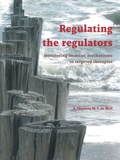Regulating the regulators
Monitoring immune mechanisms in targeted therapies
Summary
The focus of this thesis is the induction and monitoring of specific immune cell characteristics in the context of immunomodulatory therapies. Cell-based and non-cell-based therapies are discussed in three thesis parts.
In Part I, we have determined the effect of several licenced anti-viral vaccines on the frequency and phenotype of regulatory T cell (Treg) subpopulations in healthy individuals. Our results show that circulating Treg subpopulations may fluctuate to a certain extent without causing safety concerns.
Immunomodulatory treatments may not only have implications for existing Treg responses, but may also be applied to induce new Tregs. This Treg induction is the final goal in chronic auto-immune diseases -like rheumatoid arthritis- where immune tolerance needs to be re-established, for example via peptide-based therapy. In Part II of this thesis, we aimed to induce human antigen-specific T cells with immunoregulatory potential using a heat shock protein-derived peptide, which is ubiquitously expressed in inflammatory conditions. We could show arthritis-suppressing functionality of the peptide in a humanised mouse model. Moreover, peptide-specific T cells were found in human peripheral blood and could be ex vivo expanded, resulting in cells with a regulatory phenotype.
Our data now pave the way for application of heat shock protein-derived peptides as immunomodulatory therapy in inflammatory conditions. However, qualitative assessment of peptide-specific immunoregulatory T cell induction in blood of patients requires a test that is less laborious and cell-consuming than the one used for healthy donors (because of limited patient sample volumes available). We therefore explored the suitability of three relatively simple in vitro assays to demonstrate T cell responses specific for the heat shock protein-derived peptide. We could detect these T cells in several patient samples, although further assay optimisation will be required to more accurately and consistently identify antigen-specific cells with immunoregulatory characteristics that are present in low frequencies in peripheral blood.
Based on the results obtained with anti-viral vaccines and peptide-based treatments, we consider pharmacological impact on T cells important for the efficacy and safety of immunomodulatory products. Therefore, this impact on the T cell activity could already be monitored during product development. However, the extent and value of T cell monitoring performed in (non-)clinical studies has not been elucidated so far. We investigated the data availability of T cell (in particular Treg) analysis in product dossiers and published reports for immunomodulatory monoclonal antibodies. Although the available data suggest that Tregs may be used as biomarker for clinical responses, heterogeneity of experimental setups prevents appropriate comparison of different studies. Obtaining more relevant data regarding the role of T cell subsets in clinical responses will elucidate the value of T cell (and Treg) monitoring and the potential need for their evaluation in (non-)clinical studies.
Next to the non-cell-based therapies described in Part I and II, products containing somatic cells are applied to modulate the patient’s immune system. In Part III, we discuss - in the light of the European regulatory guidance for cell-based therapies- advantages and limitations of in vitro immunomonitoring assays that are frequently proposed to test the functionality of medicinal products containing mesenchymal stromal cells, T cells or dendritic cells.
In conclusion, we have shown that therapeutic products can be developed to induce or modulate immune cells and immune mechanisms. In addition, our data suggest that more indirect or unintended pharmaceutical effects on the immune system exist, although the clinical significance of these effects requires further investigation.
To improve existing therapies and develop new therapeutic approaches, the mechanisms-of-action of medicinal products and the role of immune cells in (impaired) clinical responses should be further unravelled. Applying a more standardized approach to assess relevant immune mechanisms will certainly contribute to this, especially when industry, academia and regulatory authorities join forces.
